|
The Buy Black Movement is inspired by the vision and accomplishments of Marcus Garvey, one of the greatest Black leaders in history.
Marcus Garvey's Story
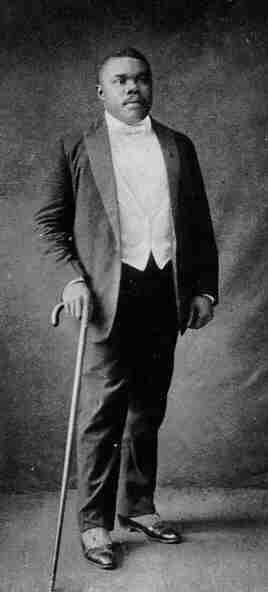 Marcus Mosiah Garvey, Jr. was born in St. Ann's Bay, Jamaica on August 17, 1887. In 1910, he began traveling throughout Central America, the Caribbean and Europe. In his travels, he saw that Black people of the time owned nothing, regardless of where he went in the world, and were not united. He was determined to do something about it. Marcus Mosiah Garvey, Jr. was born in St. Ann's Bay, Jamaica on August 17, 1887. In 1910, he began traveling throughout Central America, the Caribbean and Europe. In his travels, he saw that Black people of the time owned nothing, regardless of where he went in the world, and were not united. He was determined to do something about it.
So, in 1914, he returned to Jamaica and founded the Universal Negro Improvement Association (U.N.I.A.). The purpose of the organization was "to unite all people of African ancestry of the world to one great body to establish a country and absolute government of their own".
Garvey moved to Harlem in 1916. He started speaking on street corners at night and lecturing at various halls and churches, spreading his powerful message of unity, social freedom, political freedom and economic freedom for Black people. Garvey had an amazing ability to communicate his ideas in a way that Black people could "feel" and relate to. In May of 1916, Garvey began a historic 38-state tour and took the United States by storm.
In May of 1917, Garvey started the New York Division of the U.N.I.A. with 13 members. After only three months, the organization's dues-paying membership reached 3,500. By June 1919, the membership of the U.N.I.A. had grown to over 2 million members. By 1920, the U.N.I.A. had 1,100 chapters in 40 countries around the world. By 1926, the membership of the U.N.I.A. had grown to over 6 million members. Marcus Garvey built the largest Black organization in history.
Marcus Garvey's built huge businesses, encouraged entrepreneurship, and got millions of people buying from Black-owned business. He taught us all to be proud of our race and to unite as a people. In his own words, he taught us all to "Be Black, Buy Black, Think Black, and all else will take care of itself!". Those words have become a motto for the Buy Black Movement, a century later.
The impact of Marcus Garvey has been huge. Inspired by his ideas, over 30 African countries have declared their freedom, and many sport Garvey's red, black and green colors in their flag. Many Black leaders like the Honorable Elijah Muhammad, Malcolm X, Dr. Martin Luther King, Minister Louis Farrakhan and more, have all publicly stated that they were inspired by Marcus Garvey. In 1969, the parliament of Jamaica proclaimed Marcus Garvey as the country's first national hero.
Today, TAG TEAM Marketing is continuing the important work of Black economic independence, began by Marcus Garvey almost a century ago. Through the work of the members of the Buy Black Movement, Garvey's economic vision lives on.
Marcus Garvey's Black Businesses
 |
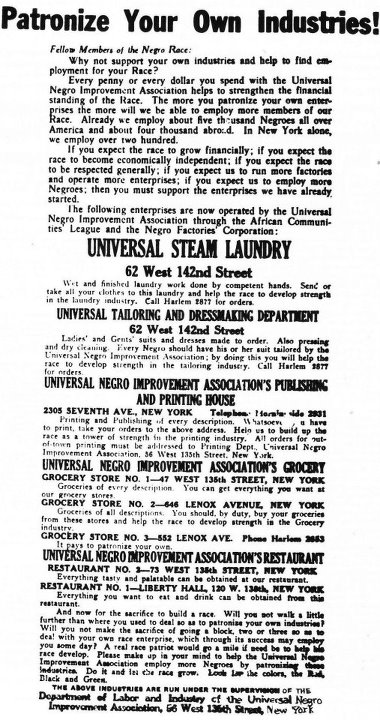 |
| 1920's Advertisements For Several Garvey Businesses |
Marcus Garvey has been called the angel of Black success. Garvey believed economic success was the quickest and most effective way to independence.
The Negro World was established in January 1918 as a weekly newspaper to express the ideas of the organization. Garvey contributed a front-page editorial each week in which he developed the organization's position on different issues related to people of African ancestry around the world, in general, and the U.N.I.A., in particular. Eventually reaching a circulation of five hundred thousand, the newspaper was printed in several languages. It contained a page specifically for women readers, documented international events related to people of African ancestry, and was distributed throughout the African diaspora until publication ceased in 1933.
In 1919 the U.N.I.A. purchased the first of what would be numerous Liberty Halls (the name given to all U.N.I.A. meeting places). Located at 114 West 138th Street in New York City, the New York City Liberty Hall had a seating capacity of six thousand. It was dedicated on July 27, 1919. Garvey held nightly meetings at Liberty Hall that
drew up to six thousand people at a time. Later that year the Association organized the first of its two steamship companies and a separate business corporation.
In 1919 he also established the Negro Factories Corporation and offered stock for African Americans to buy. He raised one million dollars for the project. He wanted to produce everything that a nation needed so that African Americans could completely rely on their own efforts. It generated income and provided jobs by its numerous enterprises, including a chain of grocery stores and restaurants, steam laundry, tailor shop, dress making shop, millinery store (clothing, fashion, hats, accessories, etc.), publishing house and doll factory.
In New York City alone, Garvey owned several buildings, owned a fleet of trucks and had over 1,000 Black people working in his businesses.
Marcus Garvey's U.N.I.A. also operated the Phyllis Wheatley Hotel and Booker Washington University (3-13 West 136th Street, New York, NY).
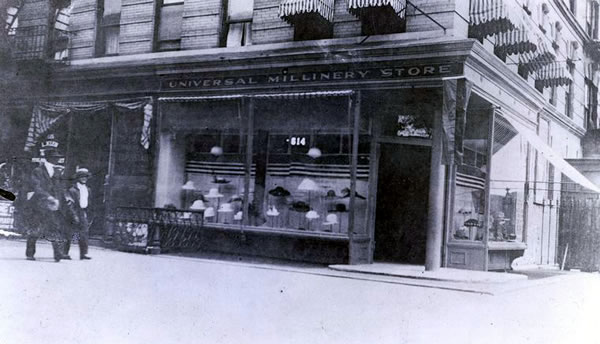 |
| One of Marcus Garvey's Stores In New York City |
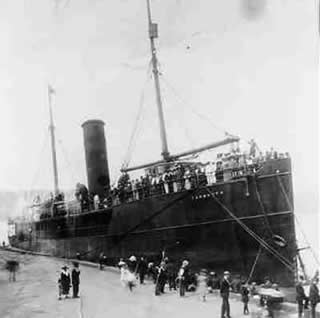 |
|
S.S. Yarmouth, one of Marcus Garvey's four
Black Star Line steam ships |
|
His most famous business venture was a shipping company known as the Black Star Line. Garvey started the shipping company in 1919 as a way to promote trade but also to transport passengers to Africa. He believed it could also serve as an important and tangible sign of Black success. The Black Star Line, Inc. was incorporated in Delaware as a U.S. domestic corporation on June 27, 1919. It began with ten million dollars in investment capital. It sold shares individually valued at five dollars to both U.N.I.A. members and non-members alike. Proceeds from stock sales were used to purchase first the S.S. Yarmouth and then the S.S. Shadyside. The Shadyside was used by the Association for summer outings and excursions, as well as rented out on charter to other organizations. The Black Star Line later purchased the Kanawha as its third vessel. This small yacht was intended for inter-island transportation in the West Indies and was rechristened the S.S. Antonio Maceo.
With the growth of its membership from 1918 through 1924, as well as, income from its various economic enterprises, U.N.I.A. purchased additional Liberty Halls in the USA, Canada, Costa Rica, Belize, Panama, Jamaica, and other countries. Furthermore, U.N.I.A. purchased farms in Ohio and other states. U.N.I.A. also purchased land in Claremont, Virginia with the intention of founding Liberty University.
By 1920 the U.N.I.A. had over 1,100 chapters in more than 40 countries. Most of the chapters were located in the United States, which had become the U.N.I.A.'s base of operations. There were, however, offices in several Caribbean countries, with Cuba having the most. Chapters also existed in such diverse countries as Panama, Costa Rica, Ecuador, Venezuela, Ghana, Sierra Leone, Liberia, India, Australia, Nigeria, Namibia and Azania/South Africa.
In September, 1926 the U.N.I.A. celebrated the opening Liberty University. They acquired Smallwood-Corey Industrial Institute located in Claremont, Virginia. The school property included several buildings and sixty-six acres of land along the St. James River. 56 young U.N.I.A. members became students there beginning with the fall session in 1926.
Garvey's U.N.I.A. Convention In August, 1920
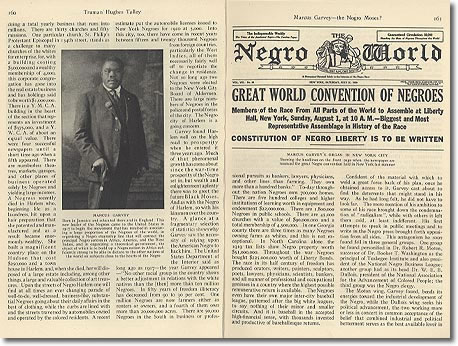
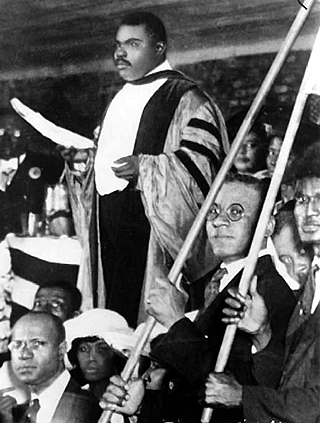 |
|
| Convention Address by Honorable Marcus Garvey Delivering Constitution for Negro Rights at Liberty Hall in New York City |
|
For the entire month of August 1920, Marcus Garvey's U.N.I.A.-ACL organization held its first international convention in New York City. Most events were held at the New York Liberty Hall. It's biggest events were held at New York City's world-famous Madison Square Garden. An estimated 25,000 Black people attended the convention from all around the world. Delegations from 25 African countries were in attendances as well.
During the convention, they discussed and created a revolutionary document called The Declaration of Rights of the Negro Peoples of the World. It was one of the earliest and most complete documents advocating human rights and detailing the abuses against Black people worldwide. It also sought the uplift of the Black race and encouraged self-reliance and nationhood.
On August 13, 1920, they voted and made the declaration official. One of the most notable declarations of this document was one proclaiming the red, black and green flag the official banner of the African race.
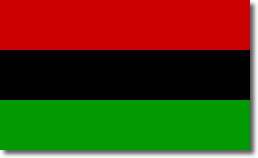
The red, black and green flag has become a symbol of Black unity and pride all over the world. Many African countries sport the colors in their flags, symbolizing their inspiration by Marcus Garvey, including Ghana, Kenya, Ethiopia and others. The red, black and green flag became a symbol of Black pride, Black power, and Black nationalism in the 1960s. The African American holiday Kwanzaa, founded in 1966, uses the colors red, black and green as well. We proudly sport the red, black and green flag in the Black Business Network.
Garvey Parades In Harlem, New York
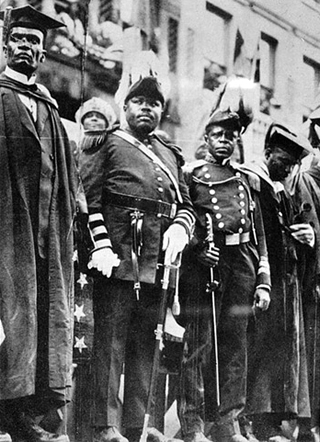 |
|
| Marcus Garvey and members in a U.N.I.A. Parade |
|
Marcus Garvey understood the importance of gathering Black people together to experience Black unity and instill race pride. Garvey held phenomenal conventions, the likes of which had never been seen before. Garvey opened his conventions with parades in Harlem that featured 100,000 Black people marching down Harlem streets. In these parades, members of the various U.N.I.A. programs wore their uniforms and marched proudly as the finest examples of Black excellence, discipline and unity most people had ever seen. The parades featured the Black Cross Nurses, Universal African Motor Corps, the Universal African Legion, The Juveniles, U.N.I.A. cultural/artistic groups and other auxiliaries, bands, and international division representatives, all in full ceremonial dress, carrying banners with the inscriptions: "Africa for the Africans!", "The Negro Wants Liberty!", and "Liberty or Death!" They were the greatest parades ever staged anywhere in the world by Black people.
Marcus Garvey wore a purple and gold uniform with a feathered helmet.
Members of the U.N.I.A.'s male Universal African Legion dressed in striking dark blue military uniforms. They studied military discipline as well as the geography of Africa, mathematics, reading and writing and other subjects . They were the most striking group of Black men ever seen by most Black people of the day.
Garvey's African Black Cross Nurses were modeled after the Red Cross. Although some members had formal medical training, most worked with practical training in first aid and nutrition. The auxiliary performed benevolent community work and provided public health services to black neighborhoods, specializing in infant health and home care. In U.N.I.A. parades, the Black Cross Nurses made a striking appearance in long hooded white robes or green nursing uniforms.
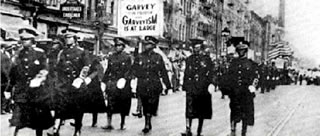 |
|
| Sisters Marching In U.N.I.A. parade in Harlem, NY |
|
Members of the female Universal African Motor Corps were trained in automobile driving and repair, as well as military discipline and marched in the parades in beautiful red, black and green uniforms.
Members of Garvey's Black Eagle Flying Corps were trained as airplane pilots. They also wore red, black and green uniforms.
The Juvenile Divisions, the youth corps of the Garvey movement, were divided into classes according to age. The infant class (ages one through seven) studied the Bible, the doctrine of the U.N.I.A., and the history of Africa. After the age of seven, the children were segregated by sex. Girls were taught sewing, boys woodcraft, and both received further instruction in Black history, economics and etiquette. After the age of thirteen, boys received military training to prepare them for membership in the African Legion, while girls learned hygiene and domestic science in order to prepare them to be Black Cross Nurses. In the U.N.I.A. parades, the boys marched in blue uniforms and the girls in green dresses.
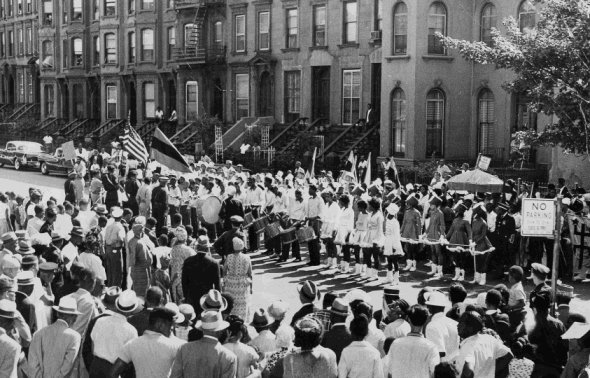 |
| Marcus Garvey Youth Parade |
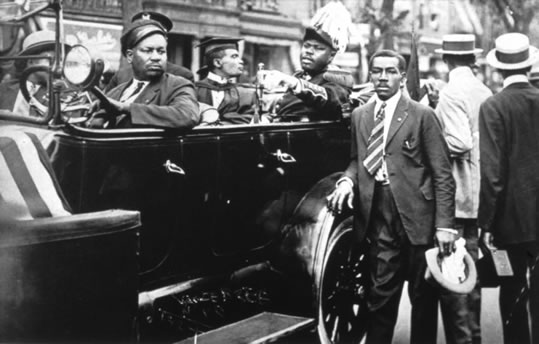 |
| Marcus Garvey's U.N.I.A. Parade In Harlem, NY |
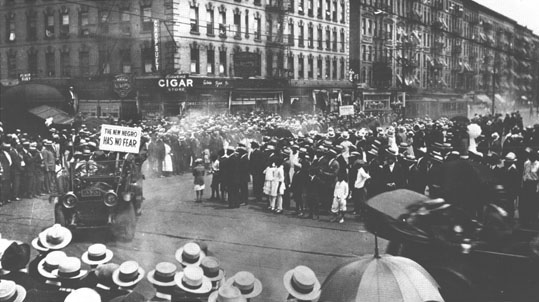 |
| Marcus Garvey's U.N.I.A. Parade In Harlem, NY, 1924 |
|
 |
 |
 |
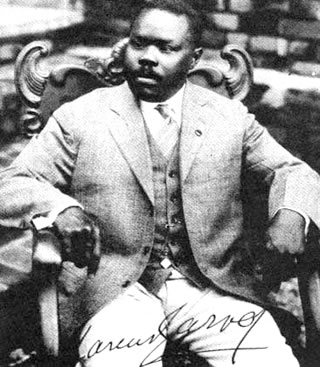
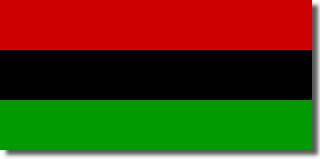 |
| Marcus Garvey's red, black & green flag. In 1920 at the U.N.I.A. convention, delegates from 25 African countries voted it the official flag of the African race. |
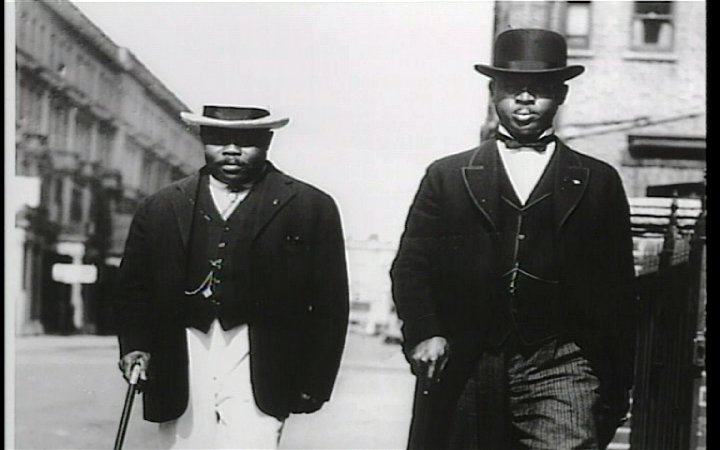 |
| Marcus Garvey walking on left |
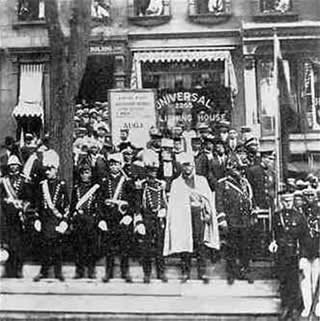 |
| Marcus Garvey and other U.N.I.A. leaders in front of U.N.I.A. Publishing House in Harlem, New York in 1922 |
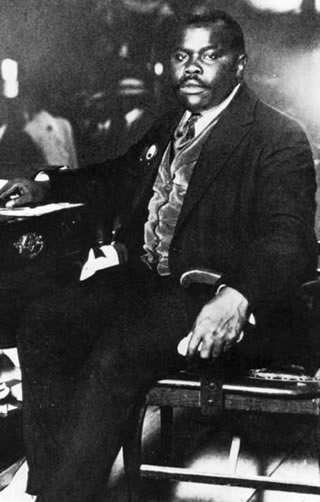 |
Marcus Garvey chairing a session of a
U.N.I.A. Convention, August 5, 1924 |
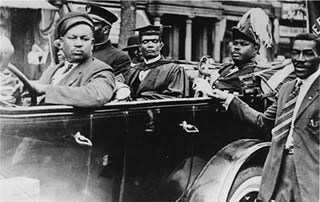 |
| Marcus Garvey in a U.N.I.A. Parade |
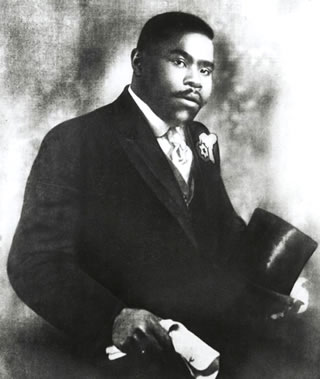 |
| Marcus Garvey's Wedding Photo, December 25, 1919 |
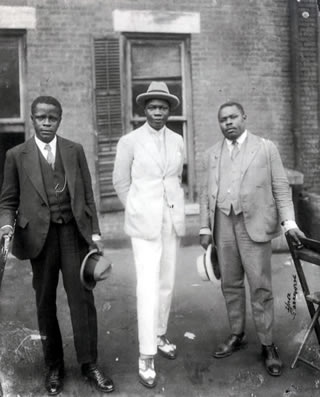 |
| Marcus Garvey (right) with Prince Kojo Tovalou-Houenou of Dahomey (center), called the "Garvey of Africa", and George O. Marke (left) in 1924 |
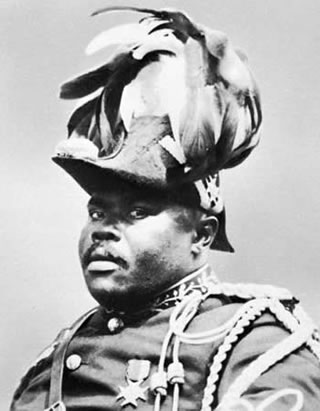 |
| Marcus Garvey in 1922 |
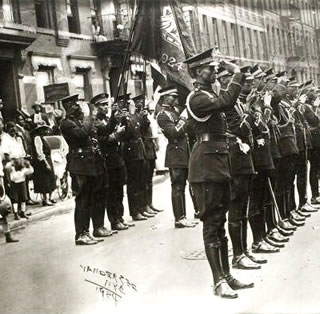 |
| Marcus Garvey's African Corps, 1924 |
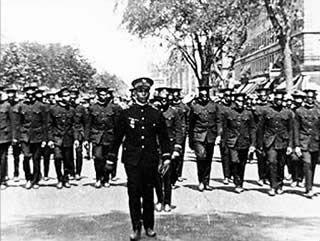 |
| Marcus Garvey's African Corps |
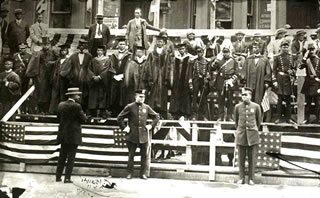 |
| Garvey and Delegation Watching U.N.I.A. Parade |
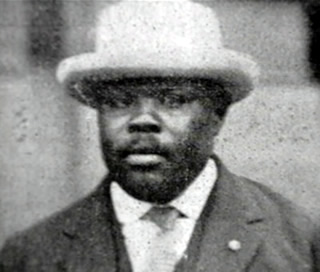 |
| Marcus Garvey |
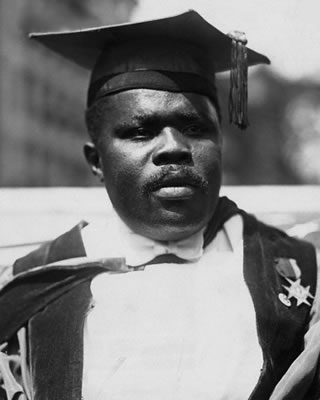 |
| Marcus Garvey in U.N.I.A. Parade in 1921 |
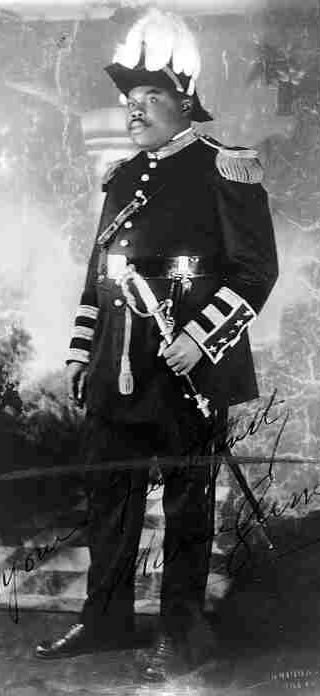 |
| Marcus Garvey in Uniform |
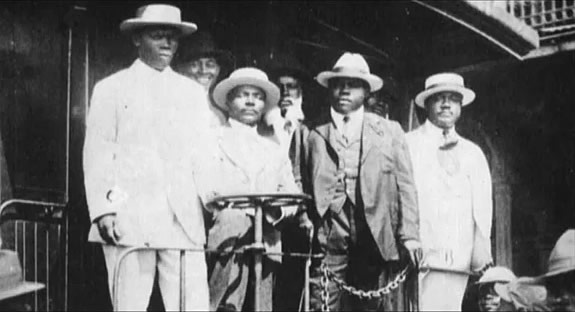 |
| Marcus Garvey Traveling On a Train in 1911 |
|